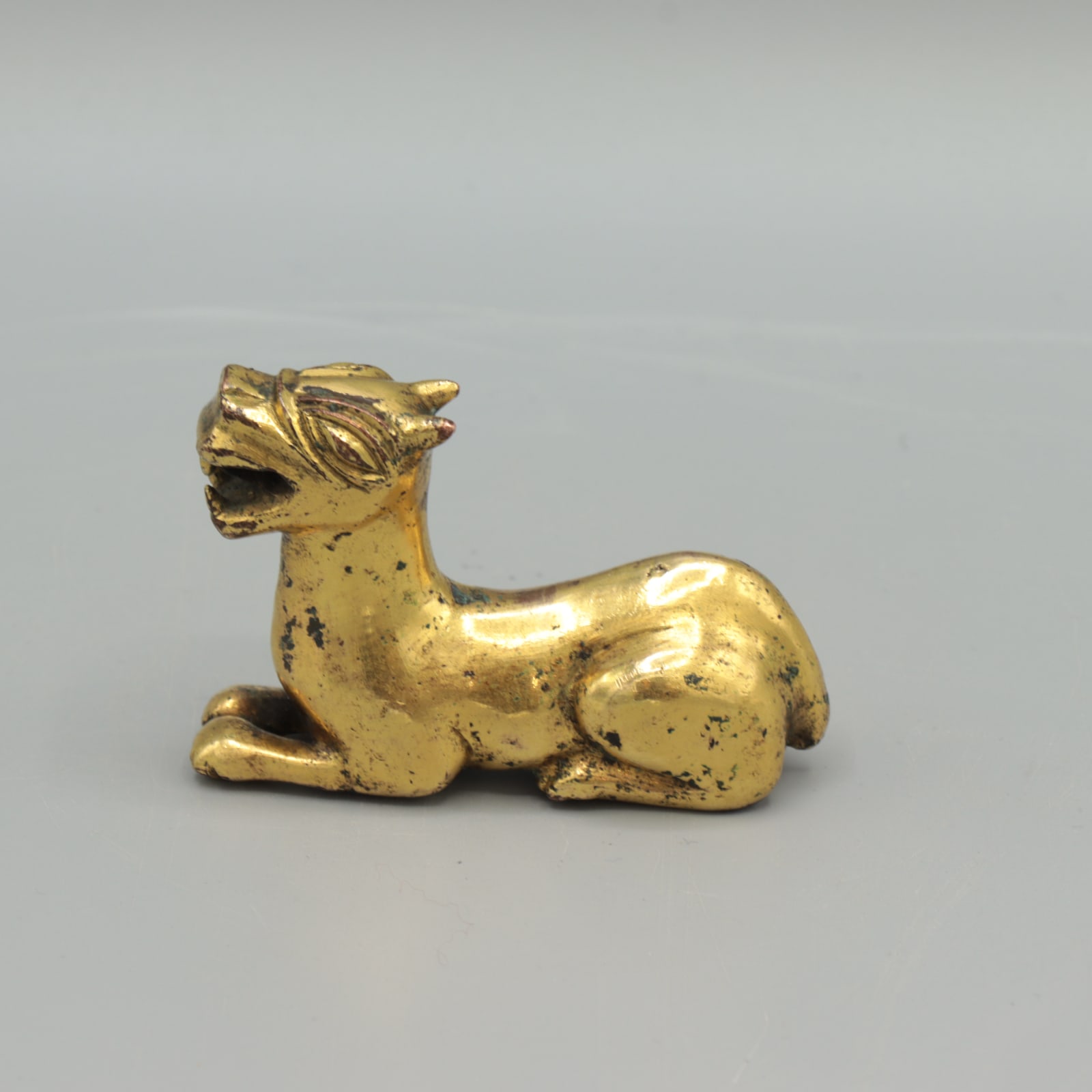Scythian Animal Figurine, 700-300 BCE
Gilt bronze
4.4 x 6.7 cm
1 3/4 x 2 5/8 in
1 3/4 x 2 5/8 in
EL.0030
Further images
The term “Scythian” has been used broadly to designate several distinct early nomadic groups which inhabited Eurasia, especially those who shared common characteristics with the “true” Scythians, such as similar...
The term “Scythian” has been used broadly to designate several distinct early nomadic groups which inhabited Eurasia, especially those who shared common characteristics with the “true” Scythians, such as similar weapons, equipment for horses, and art. The “true” Scythians (also sometimes called “Classical Scythians” or “Pontic Scythians”) were a nomadic people who had their origins in eastern Iran and migrated to the Pontic Steppe (in modern-day Ukraine and Southern Russia), occupying that area from around the 7th century to the 3rd century BC. They have been characterised as a warlike people who carried out frequent raids on surrounding populations. They were accomplished horsemen, whose main weapons were bows and arrows. They kept herds of horses, cattle, and sheep, and some became semi-nomadic on the Pontic steppe and practised more settled farming. The Scythians were involved in trade routes which were precursors to the Silk Road, and these may have offered the opportunity for the knowledge of metalworking to be transferred from the populations of Iran and China.
Metalworking became an important part of Scythian culture; it was necessary for their weapons, as well as for the creation of jewellery (which was worn by both men and women) and small decorative objects. Archaeological sites thought to have been occupied by the Scythians have revealed traces of workshops and other remnants of metalworking such as slag (a by-product of metallurgical processes such as smelting). Scythian art is characterised by its focus on animal motifs, as well as its tendency to favour portable objects because of the Scythians’ nomadic way of life. The interest in animals was probably also linked to the lifestyle of the Scythians, as they would have interacted with animals, both domesticated and wild, frequently.
This gilt bronze animal sits with its four legs neatly curled underneath its body, with its paws flat on the ground. The sinuous curve of its back and tail contrasts with the flat line formed by its head, which is tilted backwards. Despite its relaxed pose, this animal has a threatening presence; it appears to be snarling, and is baring four sharp teeth in its open mouth. Its tongue is extended, and pointed so that it looks almost weapon-like. The points of its teeth and tongue are also mirrored in its ears. Its eyes are oval-shaped, and its pupils are raised, allowing them to glitter in the light. The frequent use of animal motifs on Scythian weapons has led some to suggest that they may have believed in images of animals having the ability to transfer the attributes of that creature to the owner of the image. This animal appears to be a predator, and therefore its representation may have been designed to convey the qualities of a skilled hunter.
Metalworking became an important part of Scythian culture; it was necessary for their weapons, as well as for the creation of jewellery (which was worn by both men and women) and small decorative objects. Archaeological sites thought to have been occupied by the Scythians have revealed traces of workshops and other remnants of metalworking such as slag (a by-product of metallurgical processes such as smelting). Scythian art is characterised by its focus on animal motifs, as well as its tendency to favour portable objects because of the Scythians’ nomadic way of life. The interest in animals was probably also linked to the lifestyle of the Scythians, as they would have interacted with animals, both domesticated and wild, frequently.
This gilt bronze animal sits with its four legs neatly curled underneath its body, with its paws flat on the ground. The sinuous curve of its back and tail contrasts with the flat line formed by its head, which is tilted backwards. Despite its relaxed pose, this animal has a threatening presence; it appears to be snarling, and is baring four sharp teeth in its open mouth. Its tongue is extended, and pointed so that it looks almost weapon-like. The points of its teeth and tongue are also mirrored in its ears. Its eyes are oval-shaped, and its pupils are raised, allowing them to glitter in the light. The frequent use of animal motifs on Scythian weapons has led some to suggest that they may have believed in images of animals having the ability to transfer the attributes of that creature to the owner of the image. This animal appears to be a predator, and therefore its representation may have been designed to convey the qualities of a skilled hunter.











